General Fire Prevention Tips
Preventing Children from Starting Fires
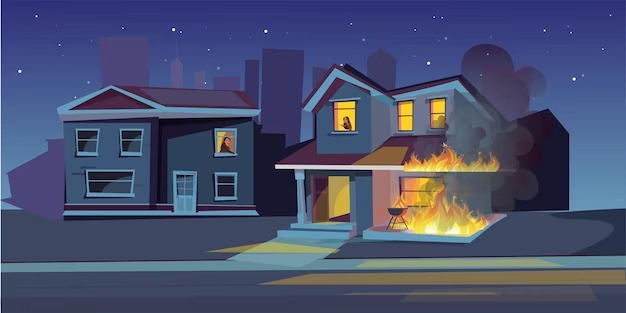
- Keep matches, lighters, and candles out of young children’s reach.
- Educate children on the dangers and hazards of fires.
- Children playing with sparklers must be supervised by parents / adults.
Handling Sparklers

- Sparklers should be kept in a closed box and away from flames.
- When being used, it should be lit at arm’s length and only one at a time.
- Lighted sparklers should never be thrown at combustible materials.
- When a sparkler goes out, do not immediately touch the hot end as it could still be burning. Ideally, put the hot end in a bucket of water to fully cool it down.
- Finally, follow the safety instructions as stated by the manufacturer.
When to see a doctor

Treating Burns & Scalds
Burns and scalds are injuries to body tissue caused by heat, chemicals, or radiation.
- Reduce the spread of heat, pain, and swelling by placing the burnt area under cold running water or immersing it in cold water for at least 10 minutes.
- Gently remove any rings, watches, belts, or constricting clothing from the injured area before it starts to swell.
- Cover the injured area with clean, preferably sterile, non-fluffy material.
- A burnt face may be covered with a gauze mask, with holes, cut into it to assist the victim in breathing.
- Do not break blisters or remove anything that is sticking to a burn.
- Do not apply lotions, ointments, or fat to the injured area.
If your clothing catches fire

- Stop. Do not panic and run.
- Whether indoors or outdoors, drop down immediately, covering your face with your hands.
- Roll over and over to put out the flames. Rolling smothers the flames by removing the oxygen. Covering your face with your hands prevents the flames from burning your face and help keep fumes and smoke from reaching your lungs.
What to do if you are trapped
Don’t panic. Stay calm and follow these steps:

- Enter a safe room, preferably one that overlooks a road.
- Shut the door behind you. Cover the bottom gap of the door with a blanket or rug, to prevent smoke from seeping through.
- Shout for help from the window or other openings to alert passers-by. Then wait for rescue to arrive.

- If you have a mobile phone, call 995 and inform the operator of your location (e.g. room number / position / floor), what is on fire and how many persons are trapped.
- Do not attempt to jump out of the building. Help will be on the way very soon.
Escaping through Smoke

If you have to escape through smoke, keep low by crawling on your hands and knees. In a fire, smoke will naturally rise, leaving some fresh air about 30cm to 60cm above the floor. Crawling keeps your head in this safety zone, away from the toxic smoke.
Smoke Detector
WHAT IS A SMOKE DETECTOR?
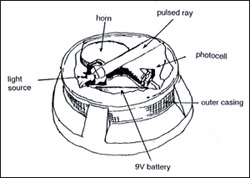
A device to detect smoke and produce an alarm sound automatically.
It consists of 2 parts: a sensor to detect smoke and a very loud electric alarm to alert people of a fire nearby.
Two most common types of smoke detectors: Photoelectric detectors and Ionisation detectors.
The recommended type for use in Singapore is the photoelectric type.
WHY DO WE NEED A SMOKE DETECTOR?
- Smoke is the main cause of death in many fatal fires.
- Smoke contains many toxic gases and particles.
- It affects visibility, impairs judgment and causes disorientation, asphyxiation and eventual death.
- A small quantity of carbon monoxide from the smoke is sufficient to kill a person.
- Installing smoke detectors in homes will give early warning to the occupants, allowing them to escape before the smoke becomes too thick.
WHEN AND HOW DO WE MAINTAIN A SMOKE DETECTOR? - Test your detector regularly. Check on the instruction manual for the recommended period.
- Use soft brush attachment and vacuum all slots in the cover and side monthly. Vacuum more often if dust, dirt, or grease accumulates easily.
- Change the battery when necessary (e.g. beeping sound every few minutes). A yearly change is usually sufficient.
WHERE SHOULD YOU INSTALL THE SMOKE DETECTOR? - At the ceiling and in the vicinity of the bedroom / sleeping area / kitchen.
- Occupants may consider additional smoke detectors for increased protection in areas such as the living room, dining room, and the utility room, where fires are likely to occur.
Operating a Manual Call Point and Hose Reel

In the event of a fire, break the glass of the nearest manual call point that you see. This will cause the fire alarm system to sound throughout the building.
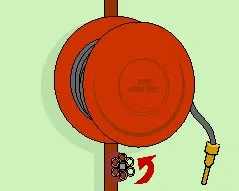
- Turn on the hose reel valve before releasing the hose reel.
- Run out the hose.
- Turn on water at nozzle and direct the stream of water at the base of the fire.
Choosing a Fire Extinguisher
A fire extinguisher is a handy item to keep around the home, in a school, office or factory. Portable and effective; it is usually the first line of defence which can be used to put out a small fire.
Extinguishers may use water, dry powder, foam, or carbon dioxide as the extinguishing medium. The table below recommends the most appropriate extinguishers for different types of fires
| Type of Fire | Recommended Type of Extinguisher |
|---|---|
| Fires arising from wood, cloth, or paper | Water extinguisher |
| Fires arising from flammable liquid | Dry powder extinguisher, foam extinguisher |
| Electrical fires | Dry powder extinguisher, carbon dioxide extinguisher |
Where to place a Fire Extinguisher
-
Extinguishers should be placed in an easily visible and accessible location, preferably near room exits, corridors, stairways, lobbies and landings.
-
Extinguishers should not be located in places where they may be exposed to special risks such as corrosive atmospheres or splashing by corrosive fluids.
-
Extinguishers shall be mounted on walls by the hangers or brackets supplied.
-
If the special risk is in a confined space, it is generally advisable to position it outside that space.
-
Cabinets if any housing fire extinguishers, should not be locked. If it needs to be locked to prevent malicious use or physical damage, a glass-fronted box should be used and the key to be located next to or part of the cabinet.
-
All free-standing extinguishers may be placed on shelves or on the floor, if permitted by relevant authorities.
-
Extinguishers shall be installed so that the carrying handle of the extinguisher is not more than 1.5 metres above the floor.
Operating a Fire Extinguisher
Operating a fire extinguisher is easy and anybody can do it. Just follow these simple steps – Pull, Aim, Squeeze and Sweep (PASS).
| P | Pull out safety device of fire extinguisher |
A | Aim nozzle at base of fire |
S | Squeeze top lever of fire extinguisher |
S | Direct discharge at fire using sweeping motion |
Open all windows to allow sufficient ventilation |
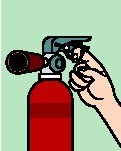 |
 |
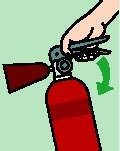 |
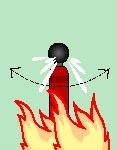 |
 |
||||
| Hold the extinguisher in an upright position.
Pull out the safety device which is fitted to prevent accidental discharge. |
Aim the extinguisher nozzle at the base of the fire.
Keep a safe distance of about 1 to 1.5 metres away from the fire. |
Press the top lever of the extinguisher. | Use a sweeping motion to allow discharge to be directed over the entire area of the fire. | When the fire is extinguished, open all doors and windows to ventilate the area. | ||||
What to do if a fire breaks out
If you discover a fire, do not panic. Just follow these simple steps:
| Evacuate premises | Contain fire | Turn gas mains off and call for help | Fight fire without endangering self |
 |
|||
| Get everyone out. | Close the door to contain the fire | Turn off the gas mains if you can reach it. Call 995 for SCDF. | Fight the fire if you can, but only do so without endangering yourself or others. |

